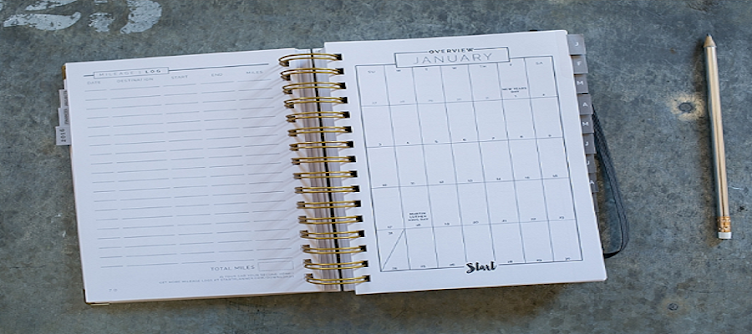
“And suddenly you know… it’s time to start something new and trust the magic of new beginnings.” ~Unknown
Did you know that 80 percent of New Year’s resolutions fail?
That’s pretty crazy. Maybe you’re part of that statistic. Feeling eager, excited, and ready for change only to fall back into old patterns after a few weeks.
This was me, year after year—striving for change but not managing to pull it through, but not last year.
A few days ago I found a letter I had written to myself on New Year’s Eve in 2016, describing how I wanted 2017 to unfold. I described what I wanted to accomplish for my business, the kind of people I wanted to surround myself with, and most importantly, how I wanted to feel through it all.
To my surprise, I noticed how much I actually had accomplished. Even though my letter was very ambitious (oops, went down that road again…), I noticed how my vision, focus, and intentions had placed me in the right direction throughout the year.
In previous years, my focus had been on achieving things such as exercising three times per week, eating only healthy food, and quitting bad habits. You know, concrete results. This time, however, my focus was on working toward my vision of the future I desire while growing and enjoying myself in the process.
In simple terms: making sure I was happy while working toward a compelling future. So, whenever I put down a goal, I also made sure to define how I wanted it to feel.
For example, instead of deciding “I’m going to exercise three times per week” I wrote “I’m gonna love my body and take really good care of it by practicing yoga, dancing, or doing other activities I feel drawn to do.”
To help stir your imagination for the New Year—so that you’re not pushed by pressure, but instead pulled by pleasure—I’ve listed nineteen things you could start doing.
1. Start focusing on what you already have.
It’s easy to focus on scarcity. To turn your focus toward what you currently don’t have in your life. In this social media-dominated, hyper-commercial, and filtered society, a state of lack can often get the best of us. But, as Oprah said, “Be thankful for what you have; you’ll end up having more. If you concentrate on what you don’t have, you will never, ever have enough.”
Abundance isn’t something you acquire. It’s something you tune into. So, start noticing, focusing on, and truly appreciating what’s currently in your life. This year, I’m going to focus on the people I love, the fact that I’m healthy, and knowing that I’m in charge of where I steer my life.
2. Start using your imagination for creating.
Imagination is a powerful thing. It can either show you the most catastrophic scenario or allow you to play, explore, and create in your mind. Your imagination can either be your greatest tool in turning your dreams into reality or your greatest roadblock.
Use it to create, not destroy. Use it to stir faith, not doubt. Use it to become a force for good, both for yourself and those around you. For example, instead of focusing on everything that could go wrong if you start your own business, imagine how fulfilled you’ll feel and all the people you could help.
3. Start living in the now.
Often, we live in past or future tense. Often, we’re so caught up in what took place or what might happen that we lose sight of what is happening. Start living where life actually takes place: here and now.
Use your senses to become present: feeling, hearing, seeing, tasting, and touching. Say yes to what you’re doing, no matter how insignificant it might seem.
When you’re washing the dishes, make that the most important thing in your life. When you’re transporting yourself, make that the most important thing in your life. When you’re speaking to someone, make that the most important thing in your life.
4. Start ignoring what others are doing.
It’s easy to fall into the trap of comparison. To look at others and either judge, blame, or feel sorry for ourselves. But, we don’t grow green grass by focusing on our neighbor’s garden; we do it by nurturing our own.
Don’t compare your behind-the-scenes to someone’s greatest moment. Instead, choose to honor your life by creating, investing in, and caring for it. Simply, keep your eyes on your lane.
5. Start being really honest with yourself.
The only way to change something is to first acknowledge what is. To look at the situation exactly as it is but not worse than it is. To look your fears, limitations, and blockages right in the eye.
What’s working and what isn’t? What do you want to do that scares the crap out of you? Give yourself credit for what’s working and then look at how you can change what isn’t. As they say, the truth will set you free. But first, it might hurt or piss you off.
6. Start putting better labels on things.
What glasses are you wearing? The optimistic, fearful, or I-cannot-do-this pair? How we experience life depends on how we choose to look at things. Losing a job can either mean a problem or a great opportunity. A breakup can either mean the end or the beginning of something new.
Label things in a way that empowers you. Turn a traumatic event into a blessing in disguise, a difficult situation into a challenge, and an ending into a new beginning. Be the author of your experiences.
7. Start telling empowering stories.
Building on the previous point, notice what stories are currently running through your life. Maybe it’s about your parents, financial situation, or health condition. The stories we tell define us. Empowering stories create empowering situations.
One story I used to tell myself was that “I wasn’t ready” to do things in my business, to launch products or workshops. Once I changed the story to “I’ll do the best I can and learn along the way,” taking action and expanding my comfort zone felt doable.
Look at one area of your life you’d like to change. What is the story you tell yourself about this area? How can you tell a better, more empowering story?
8. Start focusing on something greater than you.
In life, we either show up for what we do, how we do it, or why we do it. Having the last one (“the why”) defined is what brings purpose and meaning. What’s your mission, change you want to see, or reason for pursuing something?
Participating in something greater than yourself and being clear on why you’re doing it adds purpose. And if you don’t know what that something greater is yet, make it your mission to find out.
9. Start acting like you care about yourself.
Do you truly care about yourself? Do you act, speak, and treat yourself like the lovable and loving person you are? Because, here’s the thing: we cannot give what we don’t have. Just like we need to put our own oxygen mask on first when flying, we need to tend to ourselves first before we can tend to others.
Know that putting yourself first isn’t selfish; it’s necessary. Look at your mental, physical, emotional, and spiritual aspects. What do you need more or less of to feel good? Then, make it a priority to care for yourself (so that you also can give from a genuine place).
10. Start trusting that others are doing the best they can.
Trust that everyone is doing the best they can based on their experience, beliefs, and state. The person who cut you off in traffic might be in a rush to get home to a sick loved one. The person who didn’t deliver his project on time might be experiencing heartbreak. The person who was rude to you in the queue might be having a really bad day.
You never know what someone else is going through. So, instead of making assumptions, trust that they’re doing the best they can. Lead from a place of compassion, not judgment, and you’ll spare yourself (and others) unnecessary pain, anger, and frustration.
11. Start asking better questions.
Questions such as: “What can go wrong?” or “What if I screw up?” simply don’t have a positive answer. Your mind will go looking for whatever answer you ask for, so start asking wisely. Sure, you can ask them to get clear on the worst-case scenario, but then make sure to shift focus.
As Tony Robbins said, “Quality questions create a quality life. Successful people ask better questions, and as a result, they get better answers.” Instead, try asking questions such as “How can I make this a success?” and “How can I find the best solution to this situation?”
12. Start caring about things that actually matter.
If you care too much about things such as judgment and criticism, you’ll mostly keep yourself stuck and paralyzed—unless you find things to care more about.
For example, do you care more about what others might think or living life true to yourself? Do you care more about negative comments or being a force for good in this world? Don’t numb your care; instead, care more about things that actually matter to you.
13. Start trusting yourself wholeheartedly.
Just like any other relationships, the one with yourself needs to be fueled, nurtured, and taken care of. When you feel curious, intrigued, or excited about something, trust that it’s happening for a reason. When you get red flags about a person or situation, trust that it’s also happening for a reason.
Start acting like you trust yourself fully. Behave like you’re in full connection with your inner self and always guided. The more you act like you trust and believe in yourself, the more that will actualize for you.
14. Start celebrating your obstacles.
“Obstacles do not block the path, they are the path.” The first time I heard this Zen Proverb, I didn’t get it. How could obstacles be the path? This idea of obstacles not standing in the way but actually being the way sounded like alien language to me.
But, here’s what I discovered: Desires are powerful. Life is always guiding us toward what we want, but in that process, blockages and fears will be surfaced so that they can be seen and/or healed. So, when you’re dealing with an obstacle like fear, don’t avoid it. Instead, push yourself to work through it. Every obstacle you face brings you one step closer to your dreams.
15. Start gaining perspective on your problems.
I once heard someone say, “The problem with problems is that we think we’re not supposed to have any.” Problems might not always feel great, but they propel us forward. They shed light on what isn’t working so that we can find, explore, and investigate better solutions.
In moments of struggle, remind yourself that all over this planet, people are fighting for their survival. Acknowledge your problems but then shift toward finding a solution. What do you need to progress? Where and from whom can you gain clarity, confidence, and support to move forward?
16. Start embracing your vulnerability.
Vulnerability is scary. Yet, it’s the gateway to growth, change, and connection. It’s the last thing we want to show in ourselves, but the first thing we look for in others. We cannot shut out pain, shame, and disappointment without also blocking love, growth, and connection.
So, have the courage allow your deepest and most fragile parts to be seen. Allow your heart to crack right open and something beautiful will happen: you’ll be able to transform difficult feelings into love, strength, and compassion.
Last week, I met a girl in the co-working space where I work. It was the second time we met, yet I felt urged to suddenly share my at-the-time struggle of not feeling enough for my business and some people in my life. Apparently, she was experiencing the similar things. I left feeling relieved, empowered, and more connected to her than before.
17. Start spending time with the right people.
How are the people you spend most time with? Do they give you energy or drain you? Friendships and connections aren’t something static; they’re always in motion. Set a high standard for yourself and choose to only spend time with people you enjoy.
Make sure to surround yourself with a tribe that reflects how you want to feel and be and what you want to do and have. If you don’t have that today, then make space for those people to come into your life.
18. Start taking 100 percent responsibility for your life.
The first time I heard this, I wasn’t comfortable. Yet, the minute I accepted it, I was empowered. To accept and take full responsibility for all areas of your life (even where you feel behind, mistreated, or wronged) isn’t easy. But, it’s the only way to change them.
By taking responsibility, you bring your power back home to where it belongs: to you. So no matter how difficult it might seem, claim full responsibility for your life. You, not someone else, will get you where you want to go.
19. Start creating the life you want now.
It’s easy to postpone. To fool ourselves into thinking “Once my situation is different, I’ll act on my dream” or “Once I’m in a relationship, I’ll start loving myself.” But to live the life you desire, you’re going to have to create it now, not sometime in the future.
Conditions or timing will never be perfect. So, instead, ask yourself, “If I had all the love, money, time, confidence, and knowledge I desire, how would I think, act, and feel?” Step into that version of yourself.
Take Baby Steps Toward the Life You Desire
To get to where you want to be, you have to start walking in that direction. Don’t see it as a sprint, but more as a marathon. How can you create a manageable and enjoyable year where, not pressure, but pleasure is leading the way?
Don’t overwhelm yourself by setting too big goals or expecting things to be perfect. (They never are). Instead, choose to focus on one to three things from the list. Then once you feel comfortable with one area, move into another. Remember, consistency beats intensity.
Let this be the year you set yourself up for success!
![]()
About Maria Stenvinkel
Maria Stenvinkel is on a mission to help people get a career they truly love. Download her free worksheet Get a Clue to Your Calling With These 10 Powerful Questions.
Get in the conversation! Click here to leave a comment on the site.
The post 19 Things to Start Doing for Yourself in the New Year appeared first on Tiny Buddha.
from
https://tinybuddha.com/blog/19-things-to-start-doing-for-yourself-in-the-new-year/






























